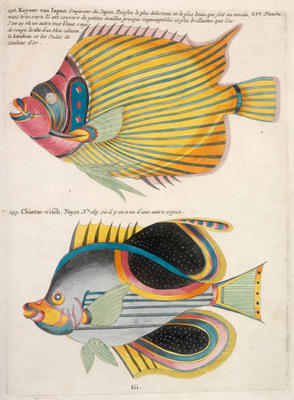

 These surreal images come from a book, Fishes, crayfishes, and crabs, of diverse colours and extraordinary form, that are found around the islands of the Moluccas and on the coasts of the southern lands (translated from french and truncated) originally published in 1719 by Louis Renard, and it was claimed it took 30 years to compile. The 460 engravings on 100 copper plates were later hand coloured and a 2nd edition of the book was published in Amsterdam in 1754.
These surreal images come from a book, Fishes, crayfishes, and crabs, of diverse colours and extraordinary form, that are found around the islands of the Moluccas and on the coasts of the southern lands (translated from french and truncated) originally published in 1719 by Louis Renard, and it was claimed it took 30 years to compile. The 460 engravings on 100 copper plates were later hand coloured and a 2nd edition of the book was published in Amsterdam in 1754.

Renard himself, comes across as a rather curious character..
"As well as spending some seventeen years as a publisher and bookdealer, Renard (c.1678-1746) also sold medicines, brokered English bonds and, more intriguingly, acted as a spy for the British Crown, being employed by Queen Anne, George I and George II. In this capacity he helped guarantee the Protestant succession to the throne by preventing stores from reaching the 'Old Pretender' James Stuart. These supposedly clandestine activities were not particularly secret. In fact, Renard used his status as an 'agent' to help advertise his books. This particular work is actually dedicated to George I while the title-page describes the publisher as 'Louis Renard, Agent de Sa Majesté Britannique'."These embellished images are said to mark an important milestone in the depiction of marine creatures. Much of the exaggeration may have crept in from repeated copying and colouring from verbal directions but, perhaps the authority on the subject, Theodore Pietsch, considers that the patterns and key character features present allow association of each drawing with a real creature.
- There are 17 plates on display at the State Library of NSW, Sydney - thumbnail page (higher resolution images available)
- Most of the information here (indeed, on the internet it seems) derives from this 1 page Special Collections exhibit at Glasgow University Library - there are a few different plates on display here.




















3 comments :
Beautiful.
The pattern on the first fish is reminiscent of a fifties dish.
Amazing post. Incredible images made better by your explanation of their origins and cultural context.
Your blog is filled with jewels. I'm enjoying the light show.
This was a serendipititious find - find of the week. The luck part comes I think because (not certain, but I think) that book is just going on display at NSW State Library so my guess is they digitized these images in concert.
boynton I feel like I see that pastel decoration everywhere, not just the 50s. In fact I think maybe in the 90s it was de rigeur for seafood restaurants to have such china (not overly a fan myself - of the washed pastel look anyway).
Thanks cruelanimal. There's some fine eyecandy out there!
Post a Comment
Comments are all moderated so don't waste your time spamming: they will never show up.
If you include ANY links that aren't pertinent to the blog post or discussion they will be deleted and a rash will break out in your underwear.
Also: please play the ball and not the person.
Note: only a member of this blog may post a comment.